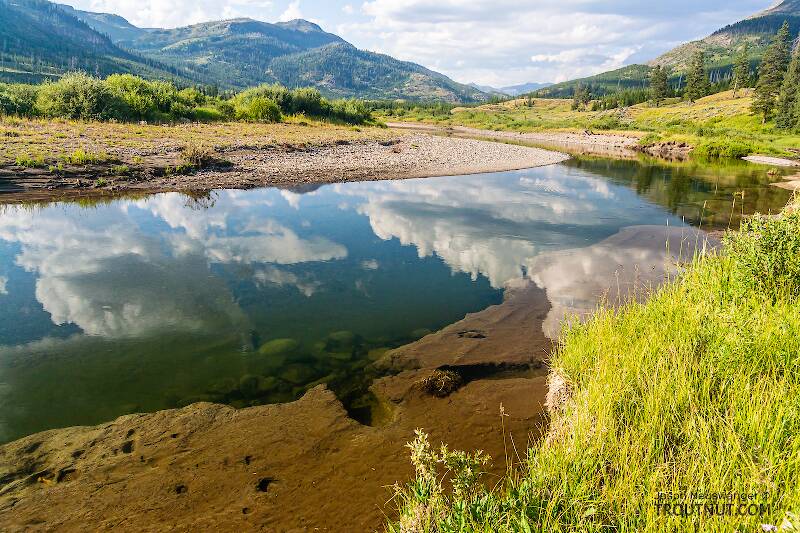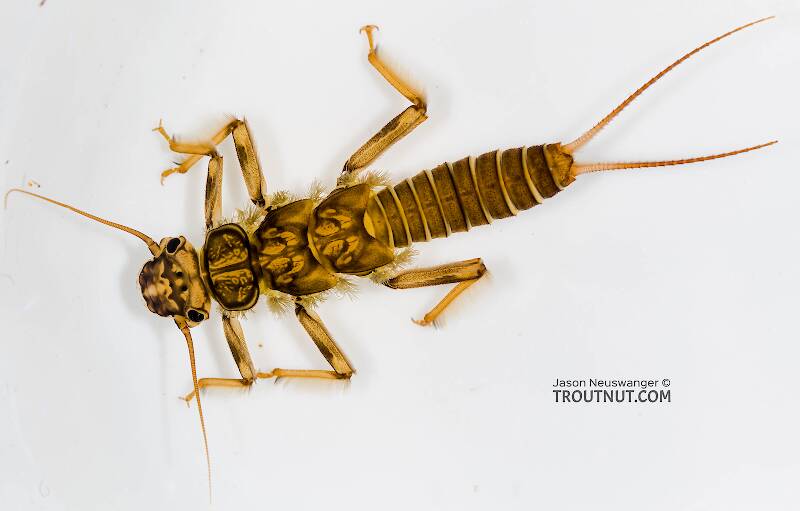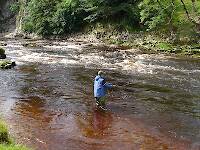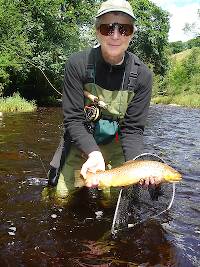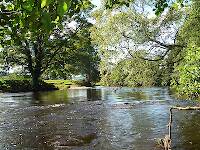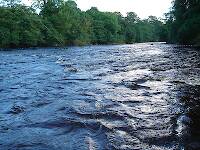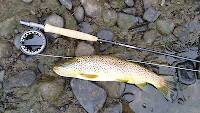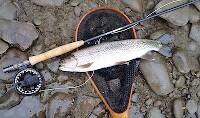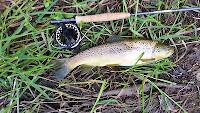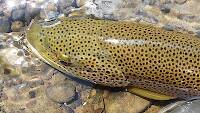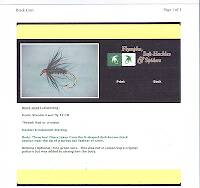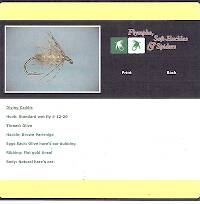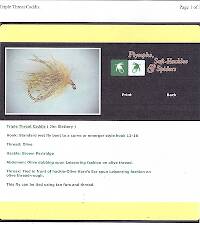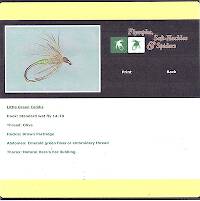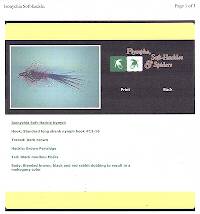
Salmonflies
Pteronarcys californica
The giant Salmonflies of the Western mountains are legendary for their proclivity to elicit consistent dry-fly action and ferocious strikes.
Featured on the forum

Troutnut is a project started in 2003 by salmonid ecologist Jason "Troutnut" Neuswanger to help anglers and
fly tyers unabashedly embrace the entomological side of the sport. Learn more about Troutnut or
support the project for an enhanced experience here.

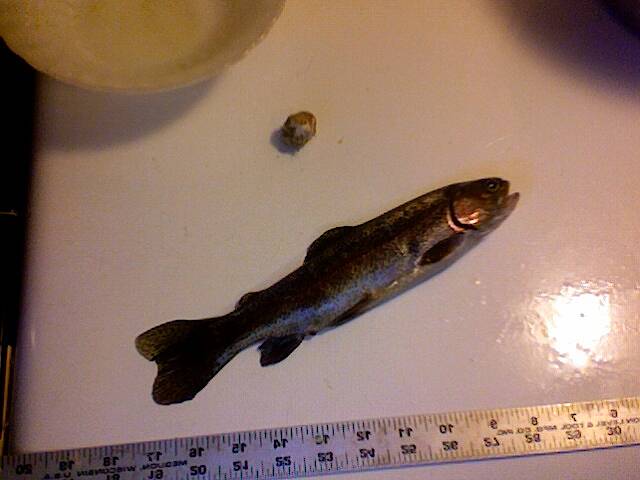
Entoman on Sep 15, 2011September 15th, 2011, 10:17 am EDT
Spence - Ah, thanks for clearing up my confusion on the issue. Your right, I assumed you were talking about some Au Sable trib.
I agree with everything you said. Wild fish and native fish are entirely different things. The former should be encouraged and the latter protected.
Regards,
Kurt
I agree with everything you said. Wild fish and native fish are entirely different things. The former should be encouraged and the latter protected.
Regards,
Kurt
"It's not that I find fishing so important, it's just that I find all other endeavors of Man equally unimportant... And not nearly as much fun!" Robert Traver, Anatomy of a Fisherman
Jmd123 on Sep 15, 2011September 15th, 2011, 12:06 pm EDT
The dams on the Au Sable are, in order upstream from the mouth: Foote, Cooke, Five Channels, Loud, Alcona, and Mio, and each impoundment is named after each dam: Foote Pond, Cooke Pond, etc. I generally think that dams should be removed whenever possible, but there are two exceptions to this:
1) Dams block some invasive species. There has been some desire to remove a low-head dam on the Clinton River downstate, which would allow more steelhead (yes, a non-native species, and maintained largely by stocking) upstream to access more spawning water, but this would also allow the two species of gobies currently wreaking havoc in the Great Lakes access to the upper portions of the river. So, most folks agree that the dam should stay, as there are numerous fisheries (including Paint Creek, a trout stream though I have caught mostly chubs there over the years - though at least they ARE native!) that would be adversely affected by an invasion of gobies.
2) Dams help block silt and sand from going further downstream, especially when that silt and sand is being put in the stream by human activities. Back in 2008, the consulting company that I worked for (and still do, though not often these days - thank goodness for my teaching job!) was called in on a massive silt spill in the Pigeon River, a famous and popular trout stream here in northern lower MI. Practically all of the trout fisherman declared that the river had been "killed" - the silt smothered all of the insect life and even killed some trout as evidenced by a dead 22-incher found floating down the stream. Well, we went in there and collected a whole bunch of benthic macroinvertebrate samples from both below the dam (which had opened accidentally and released the silt) and from above the dam, expecting, if all the fisherman were right, to find many more invertebrates above the dam (and the pond formed by it) than below it (where the silt had supposedly killed them all). Guess what? We found WAY more insects below the dam! Both in terms of sheer numbers and diversity, the reaches we sampled below the dam looked better than those above the dam, showing that the silt had in fact not killed very much of anything (and I severely doubt that in a few weeks time the bugs could have recolonized the river is such high numbers and diverse species/genera/families/orders). Above the dam we noticed something funny: there were areas of sand which contained buried cobbles and gravel, as though the sand was moving downstream and smothering the coarser substrates. (The source of the moving sand was unknown, but it sure didn't appear to be natural - I was guessing poor logging or road construction practices, as I had seen so many times in Oregon.) As many if not most of you already know, sand is the absolute worst substrate for aquatic life - the interstitial spaces are too small for most inverts and it's too unstable for burrowers (like our beloved Hexagenia mayfly nymphs) to make their small burrows in (it just collapses on them).
The dam was, in fact, holding back all of this sand that was sliding downstream and smothering not only invertebrate habitat but also spawning beds for the trout. However, the facts never really got put out there to the fishing public and the cry from the fisherman was so loud that the dam was pulled out. That dam has been in there for who knows how long - at least 50 or more years - so just imagine the waves of silt built up over those years that are now sliding down the poor stream like a mudslide going down the slopes of a volcano! My boss, who has been doing aquatic biology since the late 70's, thinks it will be several decades before the stream returns to equilibrium, and I agree with him (been doing aquatic biology for about 20 years myself).
In addition, that dam had created one hell of a trout pond. I hooked and (sadly) lost probably the biggest brown trout of my life in there, somewhere in the 20-22" range (on a Killer Bass Fly, no less, in copper and brown, a fine sculpin imitation). Which makes me wonder if that dead 22-incher seen floating down the stream hadn't come out of that pond and hit it's head on a rock in the process...
Just to back up Spence here a little with the idea that while dam removal may be desirable it isn't always ideal.
Jonathon
1) Dams block some invasive species. There has been some desire to remove a low-head dam on the Clinton River downstate, which would allow more steelhead (yes, a non-native species, and maintained largely by stocking) upstream to access more spawning water, but this would also allow the two species of gobies currently wreaking havoc in the Great Lakes access to the upper portions of the river. So, most folks agree that the dam should stay, as there are numerous fisheries (including Paint Creek, a trout stream though I have caught mostly chubs there over the years - though at least they ARE native!) that would be adversely affected by an invasion of gobies.
2) Dams help block silt and sand from going further downstream, especially when that silt and sand is being put in the stream by human activities. Back in 2008, the consulting company that I worked for (and still do, though not often these days - thank goodness for my teaching job!) was called in on a massive silt spill in the Pigeon River, a famous and popular trout stream here in northern lower MI. Practically all of the trout fisherman declared that the river had been "killed" - the silt smothered all of the insect life and even killed some trout as evidenced by a dead 22-incher found floating down the stream. Well, we went in there and collected a whole bunch of benthic macroinvertebrate samples from both below the dam (which had opened accidentally and released the silt) and from above the dam, expecting, if all the fisherman were right, to find many more invertebrates above the dam (and the pond formed by it) than below it (where the silt had supposedly killed them all). Guess what? We found WAY more insects below the dam! Both in terms of sheer numbers and diversity, the reaches we sampled below the dam looked better than those above the dam, showing that the silt had in fact not killed very much of anything (and I severely doubt that in a few weeks time the bugs could have recolonized the river is such high numbers and diverse species/genera/families/orders). Above the dam we noticed something funny: there were areas of sand which contained buried cobbles and gravel, as though the sand was moving downstream and smothering the coarser substrates. (The source of the moving sand was unknown, but it sure didn't appear to be natural - I was guessing poor logging or road construction practices, as I had seen so many times in Oregon.) As many if not most of you already know, sand is the absolute worst substrate for aquatic life - the interstitial spaces are too small for most inverts and it's too unstable for burrowers (like our beloved Hexagenia mayfly nymphs) to make their small burrows in (it just collapses on them).
The dam was, in fact, holding back all of this sand that was sliding downstream and smothering not only invertebrate habitat but also spawning beds for the trout. However, the facts never really got put out there to the fishing public and the cry from the fisherman was so loud that the dam was pulled out. That dam has been in there for who knows how long - at least 50 or more years - so just imagine the waves of silt built up over those years that are now sliding down the poor stream like a mudslide going down the slopes of a volcano! My boss, who has been doing aquatic biology since the late 70's, thinks it will be several decades before the stream returns to equilibrium, and I agree with him (been doing aquatic biology for about 20 years myself).
In addition, that dam had created one hell of a trout pond. I hooked and (sadly) lost probably the biggest brown trout of my life in there, somewhere in the 20-22" range (on a Killer Bass Fly, no less, in copper and brown, a fine sculpin imitation). Which makes me wonder if that dead 22-incher seen floating down the stream hadn't come out of that pond and hit it's head on a rock in the process...
Just to back up Spence here a little with the idea that while dam removal may be desirable it isn't always ideal.
Jonathon
No matter how big the one you just caught is, there's always a bigger one out there somewhere...
Quick Reply
Related Discussions
Topic
Replies
Last Reply
6
Nov 15, 2008
by GONZO
by GONZO
23
Oct 3, 2015
by Martinlf
by Martinlf

